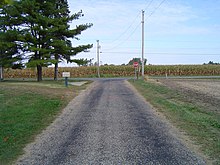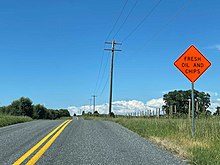Chipseal
In the United States, chipseals are typically used on rural roads carrying lower traffic volumes, and the process is often referred to as asphaltic surface treatment.Chipseals are constructed by evenly distributing a thin base of hot tar, bitumen or asphalt onto an existing pavement and then embedding finely graded aggregate into it.The aggregate is evenly distributed over the hot seal spray, then rolled into the bitumen using heavy rubber tired rollers creating a paved surface.If not removed, this can cause safety and environmental problems such as cracked windshields, chipped paint, loss-of-control crashes (especially for motorcyclists, bicyclists and small trucks), and deposition of foreign material into drainage courses.[7] There is a considerable range in acoustical intensities produced depending upon the specific tire tread design and its interaction with the roadway surface type.



pavementasphaltaggregateasphalt concretePortland cementbitumencrack reflectionemulsionsurfactantvolatile organic compoundsrolling noisecrushed stonebleedingslippery when wetroadway noiseMacadamBibcodehierarchyTypes of roadLimited-accessBicycle highwayFreeway / MotorwayDual carriageway / Divided highway / ExpresswayElevated highwayAustraliaBrazilCanadaCroatiaCzech RepublicGermanyGreeceHong KongIrelandPakistanPolandPortugalTaiwanUnited KingdomUnited StatesArterial roadCollector roadCounty highwayExpress–collector setupFarm-to-market roadHighwayLink roadTwo-lane expressway2+1 road2+2 roadParkwayRing roadTrunk roadHighway systems by countryAvenueBack roadBicycle boulevardBoulevardCountry laneDead endDrivewayFrontage roadGreen laneMain streetPrimitive roadSide roadSingle carriagewaySingle-track roadSunken laneConcurrencyDetourRoad hierarchyPrivate highwayRoute numberspecial routebusiness routeStreet hierarchyStravenueStroadToll roadWinter roadRoad junctionsInterchangesgrade-separatedCloverleafDiamondFree-flowDiverging diamondParcloRaindropRoundaboutSingle-point urban (SPUI)Three-level diamondIntersections(at-grade)3-way junctionBowtieBox junctionChannelizationContinuous flowHook turnJughandleMichigan leftOffset T-intersectionProtected intersectionQuadrant roadwayRight-in/right-out (RIRO)Seagull intersectionSplit intersectionSuperstreetTexas U-turnTurnaroundSurfacesBioasphaltCobblestoneReinforced concreteCorduroyCrocodile crackingDiamond grinding of pavementFull depth recyclingGlassphaltGravelPavement millingPermeablePlasticRubberized asphaltSealcoatStamped asphalt